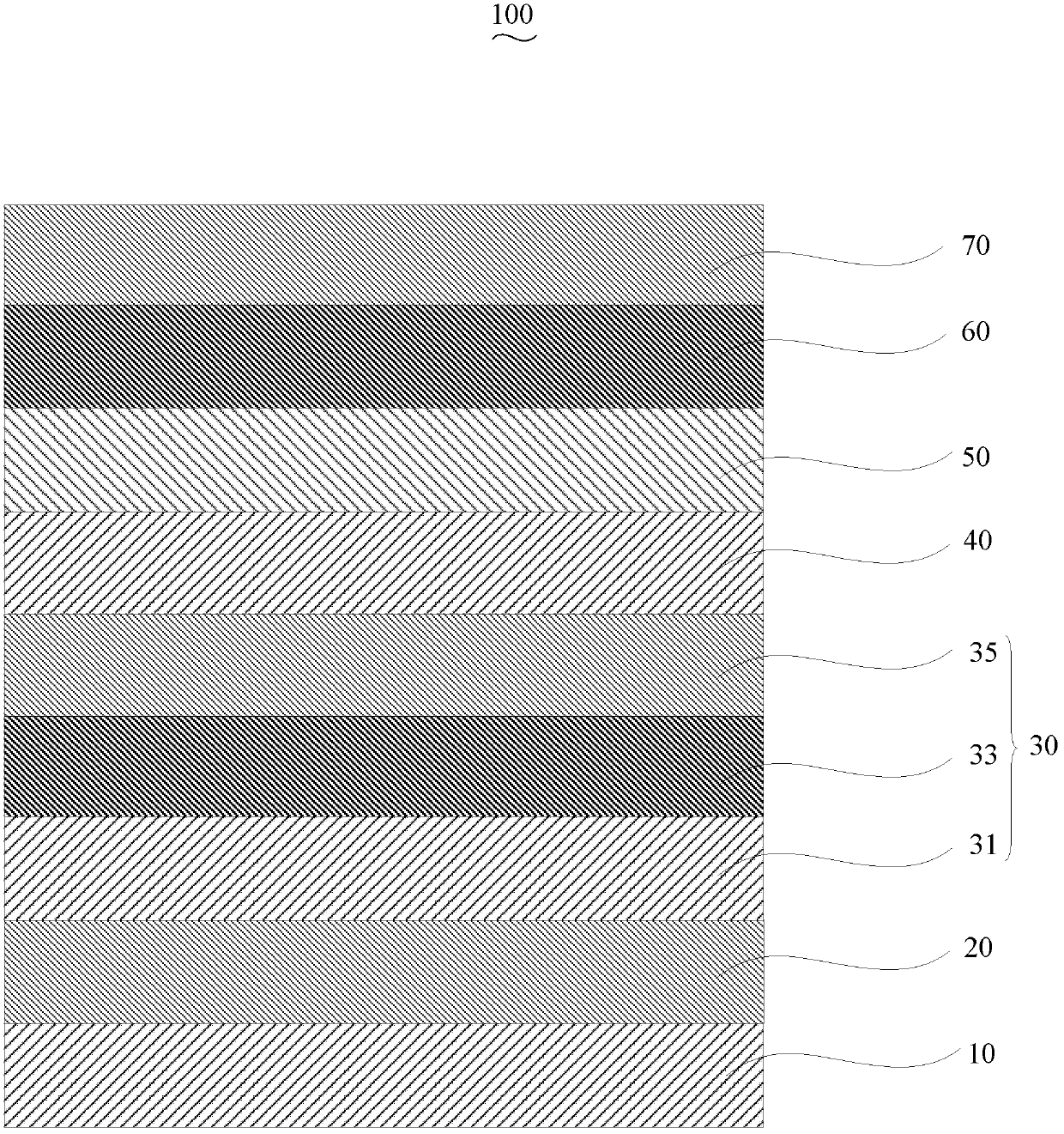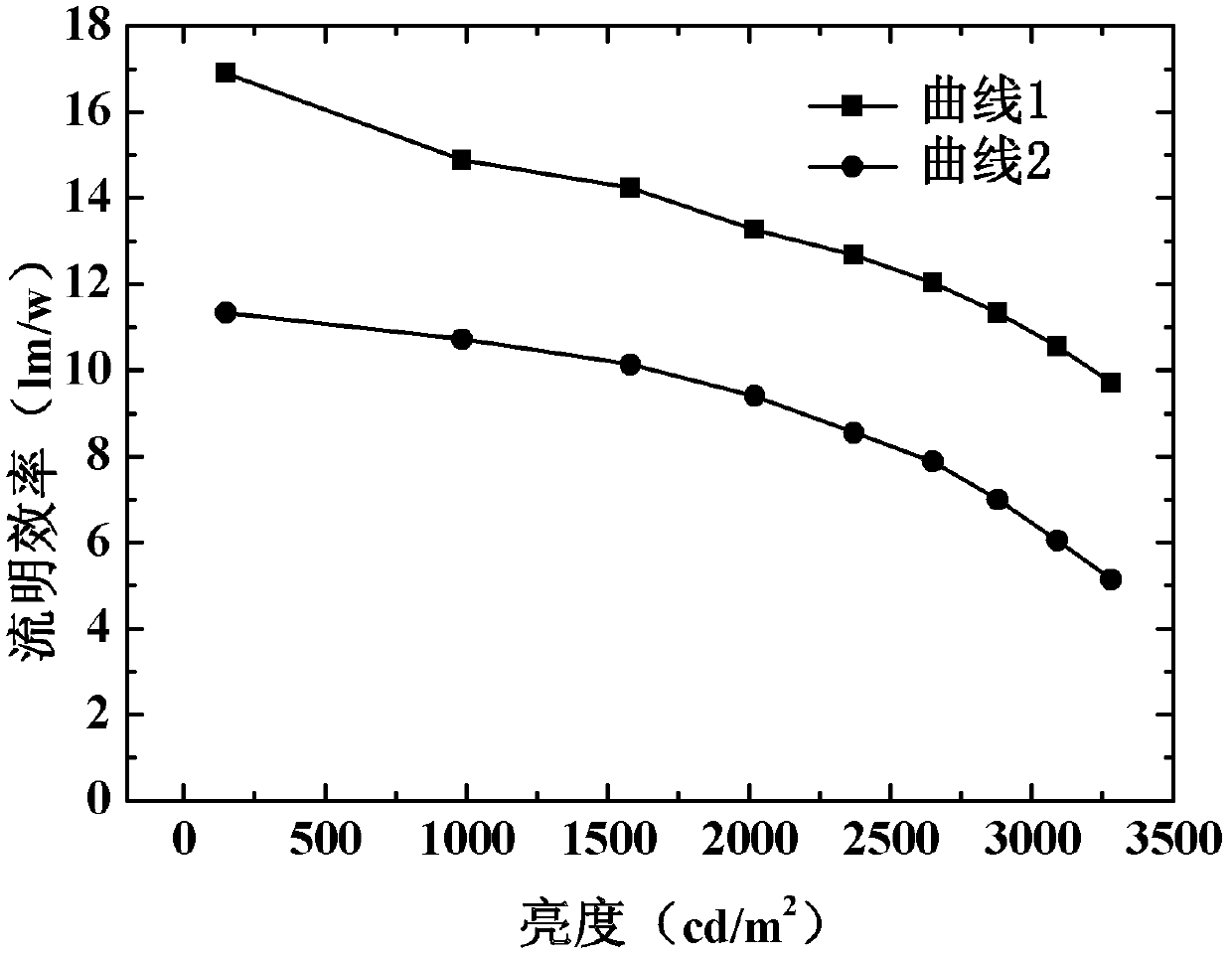Organic light-emitting device and preparation method thereof
An electroluminescent device and a luminescent technology, applied in the direction of electric solid-state devices, semiconductor/solid-state device manufacturing, electrical components, etc., can solve the problems of reducing the luminous efficiency of organic electroluminescent devices and the low probability of hole and electron recombination, etc. To achieve the effect of increasing the recombination probability and improving the luminous efficiency
- Summary
- Abstract
- Description
- Claims
- Application Information
AI Technical Summary
Problems solved by technology
Method used
Image
Examples
preparation example Construction
[0039] Please also see figure 2 , the preparation method of the organic electroluminescent device 100 of an embodiment, it comprises the following steps:
[0040] Step S110 , forming a hole injection layer 20 on the surface of the anode 10 .
[0041] The anode 10 is indium tin oxide glass (ITO), fluorine doped tin oxide glass (FTO), aluminum doped zinc oxide glass (AZO) or indium doped zinc oxide glass (IZO).
[0042] In this embodiment, the anode 10 is pretreated before the hole injection layer 20 is formed on the surface of the anode 10 . The pretreatment of the anode 10 includes removing organic pollutants on the surface of the anode 10 and performing oxygen ion treatment on the anode 10 . The anode 10 is ultrasonically cleaned with detergent, deionized water, acetone, ethanol, and isopropanone for 15 minutes to remove organic pollutants on the surface of the substrate 10; the anode 10 is treated with oxygen ion for 5 minutes to 15 minutes, and the power is 10 minutes. ...
Embodiment 1
[0059] Sonicate ITO with detergent, deionized water, acetone, ethanol, and isopropanol for 15 minutes in order to remove organic pollutants on the glass surface. After cleaning, it is treated with oxygen plasma. The oxygen plasma treatment time is 5-15 minutes. , the power is 10-50W; the hole injection layer is evaporated, and the material is MoO 3 , the thickness is 40nm; electron beam evaporation inorganic quantum well, n=2, the thickness of ZnO is 20nm, lithium salt material is Li 2 CO 3 , with a thickness of 10nm; evaporated light-emitting layer, the material is Alq 3 , with a thickness of 30nm; the vapor-deposited electron transport layer, the material is TPBi, and the thickness is 60nm; the vapor-deposited electron injection layer, the material is CsN 3 , the thickness is 5nm; the vapor-deposited cathode, the material is Ag, and the thickness is 150nm, and finally the required inorganic quantum well organic electroluminescent device is obtained.
[0060] see image 3...
Embodiment 2
[0064] Sonicate ITO with detergent, deionized water, acetone, ethanol, and isopropanol for 15 minutes in order to remove organic pollutants on the glass surface. After cleaning, it is treated with oxygen plasma. The oxygen plasma treatment time is 5-15 minutes. , the power is 10-50W; the hole injection layer is evaporated, and the material is WO 3, the thickness is 80nm; electron beam evaporation inorganic quantum well, n=1, the thickness of ZnO is 20nm, the lithium salt material is LiF, the thickness is 5nm; the evaporation light-emitting layer, the material is DCJTB, the thickness is 50nm; evaporation electron transport layer, the material is TPBi, and the thickness is 80nm; the vapor-deposited electron injection layer is made of LiF, and the thickness is 0.5nm; the vapor-deposited cathode is made of Ag, and the thickness is 150nm, and finally the required inorganic quantum well organic electroluminescent device is obtained. .
PUM
| Property | Measurement | Unit |
|---|---|---|
| Thickness | aaaaa | aaaaa |
| Thickness | aaaaa | aaaaa |
| Thickness | aaaaa | aaaaa |
Abstract
Description
Claims
Application Information
 Login to View More
Login to View More - R&D
- Intellectual Property
- Life Sciences
- Materials
- Tech Scout
- Unparalleled Data Quality
- Higher Quality Content
- 60% Fewer Hallucinations
Browse by: Latest US Patents, China's latest patents, Technical Efficacy Thesaurus, Application Domain, Technology Topic, Popular Technical Reports.
© 2025 PatSnap. All rights reserved.Legal|Privacy policy|Modern Slavery Act Transparency Statement|Sitemap|About US| Contact US: help@patsnap.com



